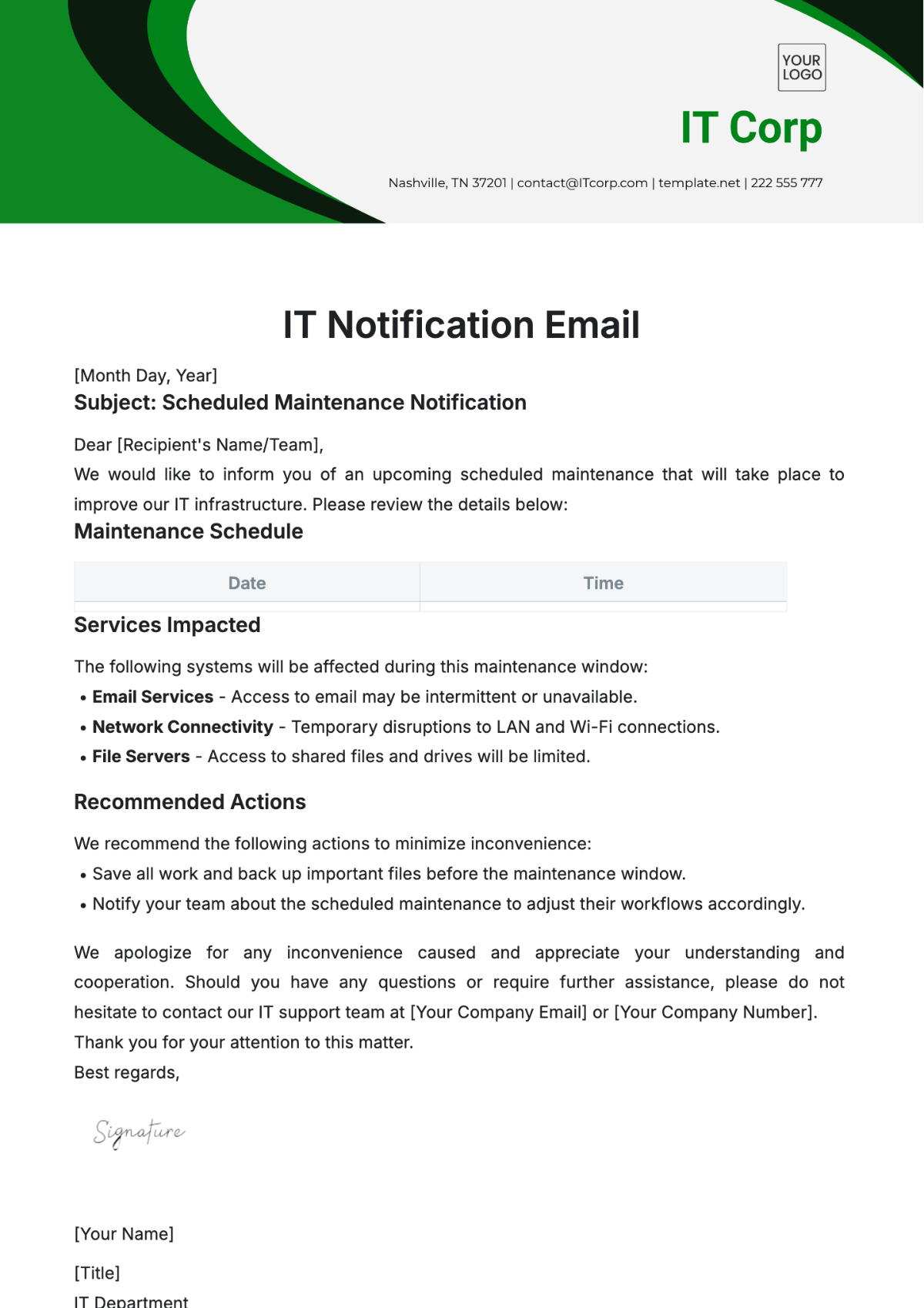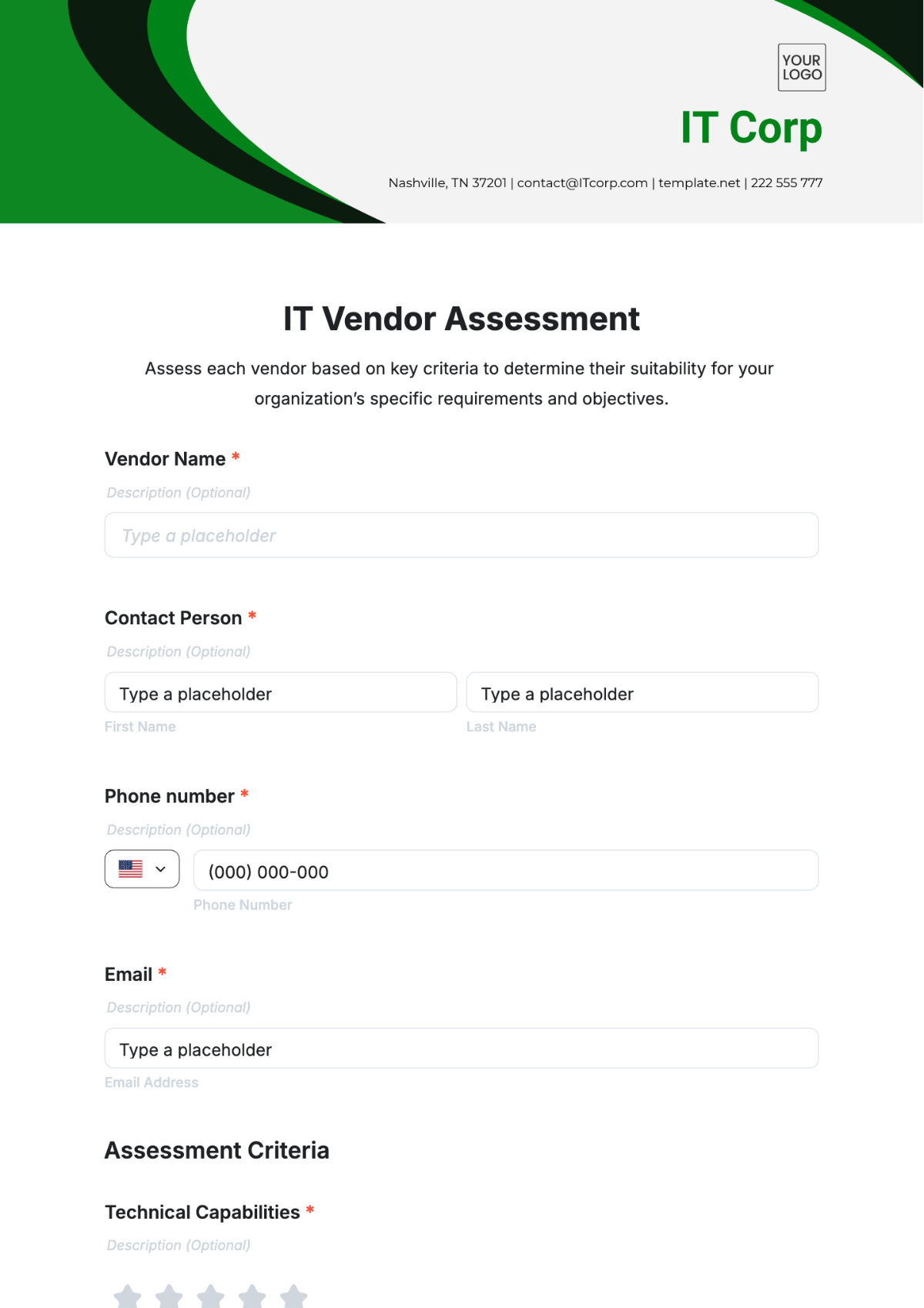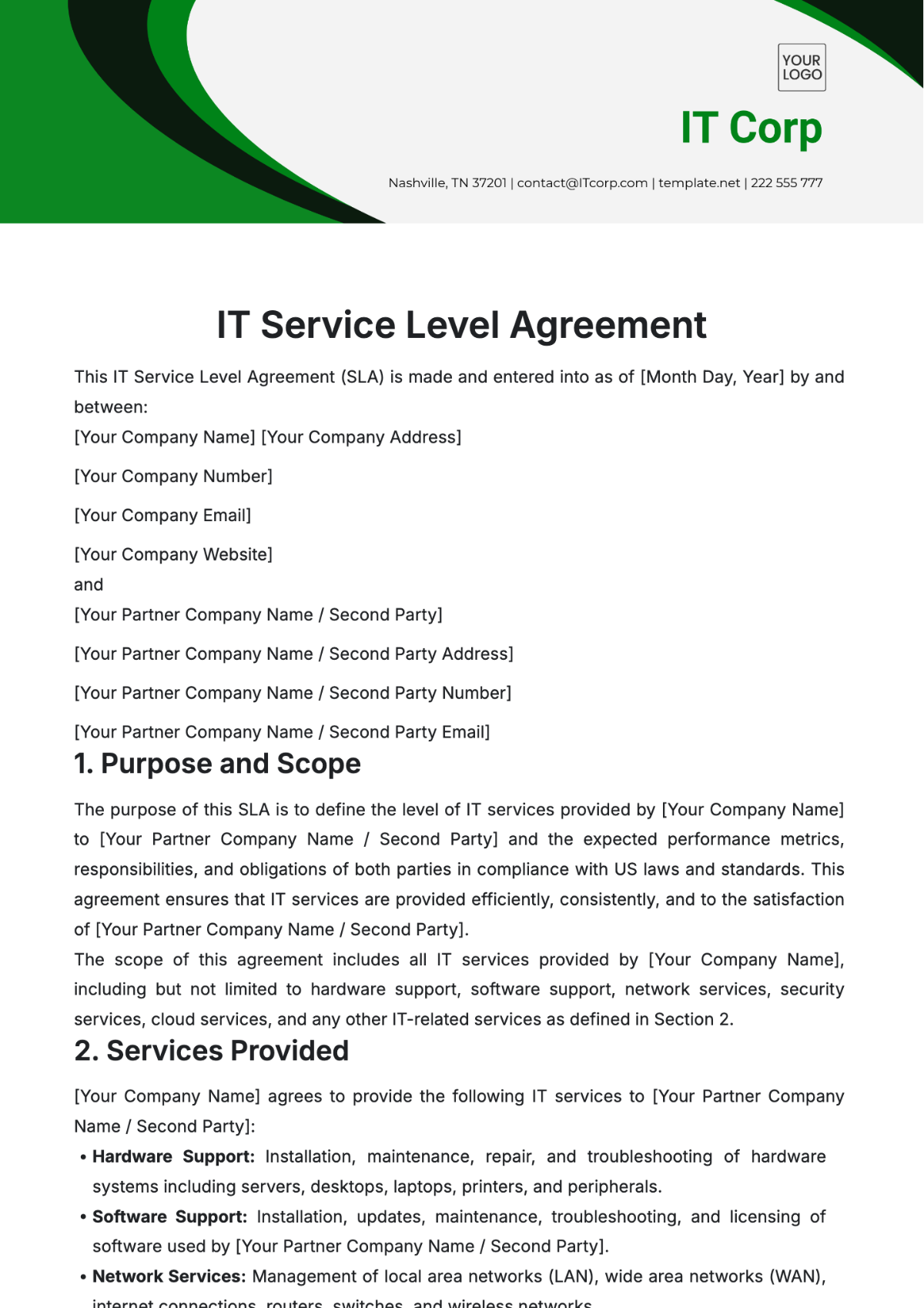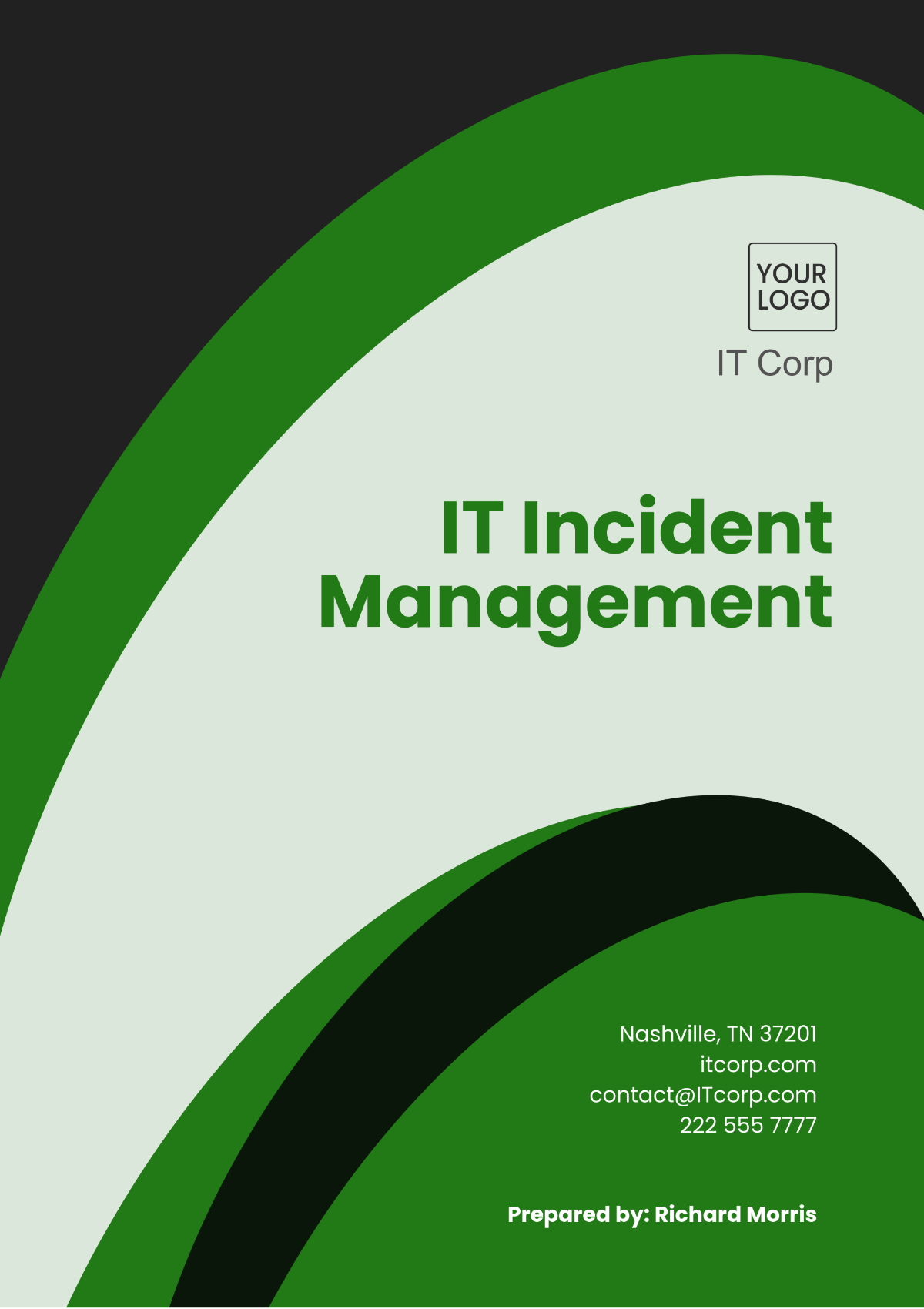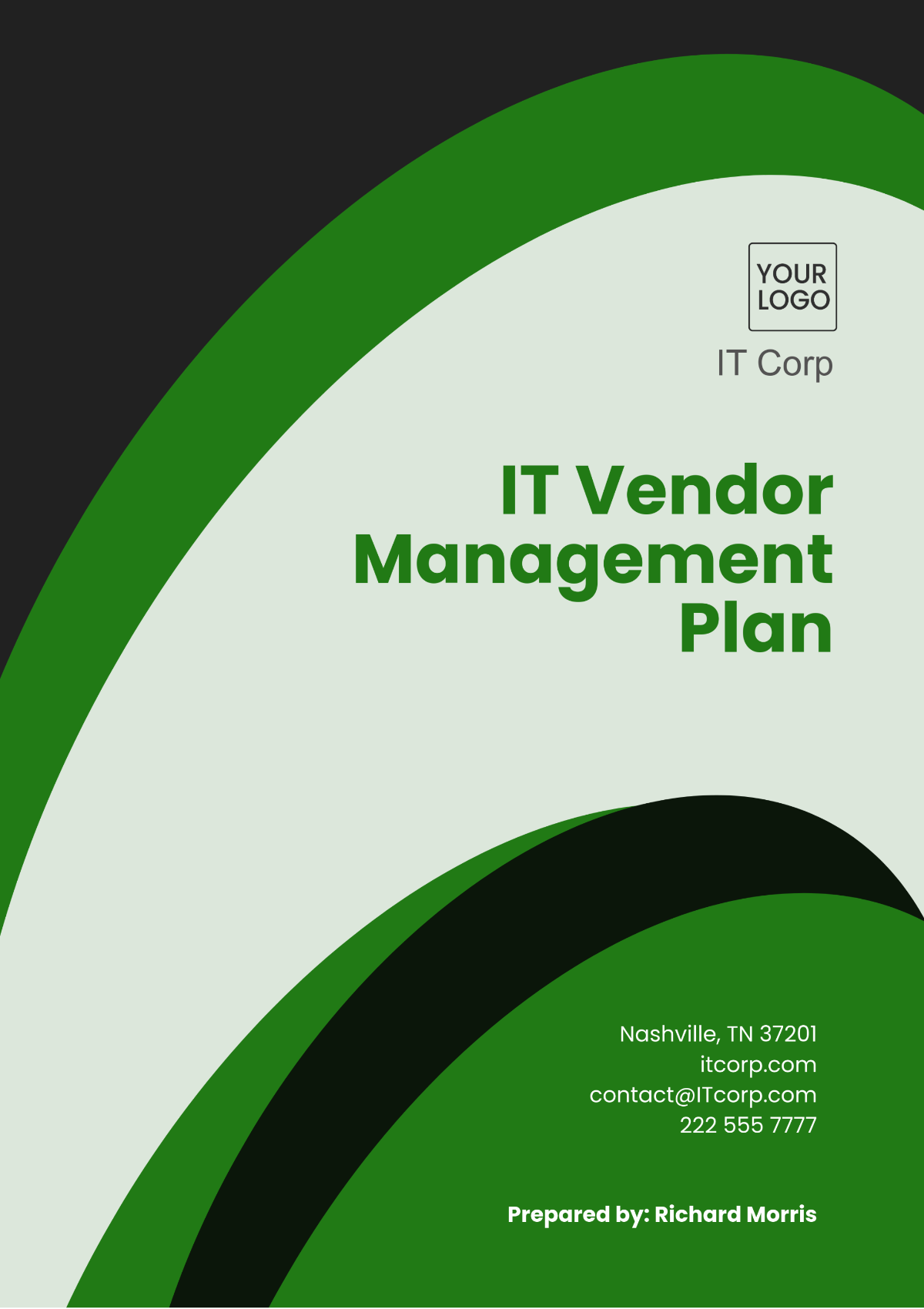IT Project Brief
Prepared by [YOUR NAME] for [YOUR COMPANY NAME]
Project Overview
The Digital Transformation Initiative aims to modernize our organization's technological infrastructure and processes to enhance efficiency, productivity, and customer satisfaction. This initiative involves the implementation of various digital solutions and the integration of emerging technologies to streamline operations and improve overall performance.
Aspect | Description |
|---|---|
Main Objectives | Implementing a new Customer Relationship Management (CRM) system to streamline sales processes, improve customer interactions, and enhance data management. |
Project Name | CRM System Implementation |
Project Leader | John Smith |
Expected Completion Date | June 30, 2050 |
Team Members Responsible for Implementation:
Project Manager: Emily Johnson
IT Lead: Michael Brown
Sales Team Representative: Sarah Lee
Customer Service Representative: David Rodriguez
Data Analyst: Jennifer Wang
Project Time Frame: March 15, 2050 - June 30, 2050
Scope of the Project
The scope of the CRM System Implementation project encompasses the following key aspects:
System Selection: Research, evaluate, and select the most suitable CRM software solution that aligns with the organization's requirements and objectives.
Customization and Configuration: Customize and configure the selected CRM system to meet the specific needs of the organization, including setting up user roles, permissions, workflows, and data fields.
Data Migration: Migrate existing customer data from legacy systems or spreadsheets into the new CRM platform while ensuring data integrity and accuracy.
Integration: Integrate the CRM system with existing tools and systems used across the organization, such as email clients, marketing automation platforms, and accounting software.
User Training: Develop and conduct comprehensive training sessions for all users to ensure they are proficient in using the new CRM system effectively.
Testing and Quality Assurance: Conduct thorough testing of the CRM system to identify and address any bugs, errors, or inconsistencies before deployment.
Change Management: Implement strategies to manage organizational change effectively, including communication plans, stakeholder engagement, and addressing resistance to change.
Documentation: Create comprehensive documentation including user guides, manuals, and system documentation to support users in utilizing the CRM system efficiently.
Post-Implementation Support: Provide ongoing support and maintenance for the CRM system post-implementation, including troubleshooting issues, implementing updates, and addressing user feedback.
Project Management: Coordinate all project activities, monitor progress, manage risks, and ensure the project stays within budget and timeline constraints.
The scope of the project does not include:
Development of custom CRM software from scratch.
Significant modifications to existing business processes outside of CRM implementation requirements.
Hardware procurement or infrastructure setup unless explicitly required for CRM system deployment.
Extensive data cleansing or enrichment beyond what is necessary for migration and initial setup.
Long-term strategic planning beyond the immediate goals of CRM system implementation.
Business Requirements
Sales Process Enhancement: The CRM system should support and improve the sales process by providing features such as lead management, opportunity tracking, sales forecasting, and pipeline management.
Customer Interaction Improvement: Enable better customer interactions through centralized customer profiles, communication tracking (emails, calls, meetings), and automated follow-up reminders.
Data Management: Facilitate efficient data management by allowing easy access, updating, and sharing of customer information across departments, while ensuring data security and compliance with relevant regulations (e.g., GDPR).
Customization and Scalability: The CRM system should be customizable to adapt to changing business needs and scalable to accommodate future growth, without significant disruptions to operations.
Integration Capabilities: Seamless integration with existing tools and systems used across the organization, including email clients, marketing automation platforms, accounting software, and other business-critical applications.
User-Friendly Interface: Intuitive user interface and navigation to facilitate user adoption and minimize the learning curve, with features such as customizable dashboards, search functionality, and mobile accessibility.
Reporting and Analytics: Robust reporting and analytics capabilities to track key performance indicators (KPIs), measure sales performance, analyze customer behavior, and identify trends for informed decision-making.
Automation and Workflow Management: Automation of repetitive tasks, workflows, and processes to increase efficiency, reduce manual errors, and improve productivity across sales, marketing, and customer service functions.
Collaboration and Communication: Encourage collaboration and communication among team members by enabling the sharing of notes, documents, and insights related to customer interaction within the CRM platform.
Training and Support: Provision of comprehensive training materials, resources, and ongoing support to ensure all users are proficient in using the CRM system effectively and maximizing its potential benefits.
Cost-Effectiveness: Consideration of total cost of ownership (TCO), including initial setup costs, licensing fees, ongoing maintenance, and support expenses, to ensure the CRM solution offers value for money.
Compliance and Security: Adherence to industry regulations and best practices for data privacy, security, and compliance, with features such as role-based access controls, audit trails, and encryption of sensitive data.
Project Plan and Timelines
A timeline of all project stages, from initiation to conclusion, with assigned team members and deadlines for each task. Tools such as Gantt charts may be used to visualize the timeline.
Initiation Phase (March 15, 2050 - March 31, 2050 ):
Project kickoff meeting
Define project scope, objectives, and deliverables
Identify stakeholders and their roles
Establish communication channels and reporting mechanisms
Planning Phase (April 1, 2050 - April 15, 2050 ):
Conduct requirements-gathering sessions with key stakeholders
Develop a detailed project plan, including tasks, timelines, and resource allocation
Create a risk management plan and mitigation strategies
Finalize the selection of CRM software solution
Procure necessary resources and tools for the project
Implementation Phase (April 16, 2050 - May 31, 2050 ):
Customize and configure the CRM system based on business requirements
Conduct data migration from legacy systems to the new CRM platform
Integrate the CRM system with existing tools and systems
Develop and deliver user training sessions
Conduct testing and quality assurance activities
Deployment Phase (June 1, 2050 - June 15, 2050 ):
Deploy the CRM system to the production environment
Provide post-deployment support and troubleshooting
Monitor system performance and address any issues that arise
Conduct user acceptance testing (UAT) and obtain feedback for final adjustments
Transition Phase (June 16, 2050 - June 30, 2050 ):
Handover project deliverables to the operational team
Conduct final project review and lessons learned session
Document project outcomes, successes, and areas for improvement
Close out the project and obtain sign-off from stakeholders
Note: Timelines are subject to change based on project requirements, resource availability, and unforeseen circumstances. Regular progress reviews and adjustments may be necessary to ensure the project stays on track.
Risk Analysis and Mitigation Plan
Data Security Breach:
Risk: Unauthorized access to sensitive customer data leads to potential legal and financial repercussions.
Mitigation: Implement robust security measures such as encryption, role-based access controls, and regular security audits. Conduct staff training on data security best practices to minimize the risk of breaches.
Vendor Dependency:
Risk: Dependency on the CRM software vendor for updates, maintenance, and support may lead to delays or disruptions in service.
Mitigation: Negotiate a comprehensive service level agreement (SLA) with the vendor, including guaranteed response times for support issues and provisions for regular updates and maintenance. Explore alternative vendors or backup solutions in case of vendor failure.
Data Migration Issues:
Risk: Challenges in migrating data from legacy systems to the new CRM platform may result in data loss, corruption, or inconsistency.
Mitigation: Conduct thorough data profiling and cleansing before migration to identify and address any data quality issues. Perform test migrations in a controlled environment to validate data integrity and ensure a smooth transition.
User Adoption Resistance:
Risk: Resistance from users to adopt the new CRM system may hinder its successful implementation and utilization.
Mitigation: Engage stakeholders early in the project and involve them in the decision-making process to gain their buy-in. Provide comprehensive training and support to users to familiarize them with the system's features and benefits. Implement a change management plan to address concerns and encourage adoption.
Scope Creep:
Risk: Expansion of project scope beyond initial requirements may result in timeline delays, budget overruns, and resource constraints.
Mitigation: Establish a robust change control process to evaluate and approve any proposed changes to the project scope. Regularly communicate project scope, objectives, and deliverables to stakeholders to manage expectations and minimize scope creep.
Integration Challenges:
Risk: Difficulties in integrating the CRM system with existing tools and systems may lead to interoperability issues and data synchronization problems.
Mitigation: Conduct comprehensive integration testing to identify and address any compatibility issues between the CRM system and other systems. Engage IT experts and vendors to develop custom integration solutions if necessary. Document integration processes and configurations for future reference.
Lack of Executive Sponsorship:
Risk: Insufficient support and involvement from executive leadership may hinder decision-making, resource allocation, and project prioritization.
Mitigation: Secure strong executive sponsorship and engagement from key stakeholders to champion the project and provide necessary support and resources. Regularly communicate project progress and achievements to demonstrate value and maintain leadership buy-in.
Regular monitoring and review of identified risks throughout the project lifecycle will be essential to proactively address any emerging issues and ensure successful project delivery.
Budget and Resource Allocation
Budget Allocation:
Total Project Budget: [Insert Total Budget Amount]
Breakdown:
CRM Software License Fees: [Insert Amount]
Implementation Services (Consulting, Training, Customization): [Insert Amount]
Hardware and Infrastructure Costs (if applicable): [Insert Amount]
Data Migration Tools and Services: [Insert Amount]
Contingency Reserve (10% of Total Budget): [Insert Amount]
Total Budget Allocated: [Insert Total Budget Amount]
Resource Allocation:
Human Resources:
Project Manager: Full-time allocation throughout the project duration.
IT Lead Full-time allocation during implementation and deployment phases.
Sales Team Representative: Part-time allocation for requirements gathering and testing phases.
Customer Service Representative: Part-time allocation for requirements gathering and testing phases.
Data Analyst: Part-time allocation for data migration and reporting phases.
Training Coordinator: Part-time allocation during implementation and deployment phases.
Change Management Specialist: Part-time allocation throughout the project duration.
External Resources:
CRM Software Vendor: Provide implementation services, training, and support as per the agreed contract.
Data Migration Specialists: Engage external consultants or services for complex data migration tasks.
IT Infrastructure Vendor (if applicable): Procure hardware and infrastructure services as required.
Contingency Resources:
Additional budget and resources are allocated for unforeseen circumstances or scope changes.
Budget Management:
Establish a project budget tracking system to monitor expenditures against allocated budget categories.
Conduct regular budget reviews and adjustments as necessary to ensure alignment with project goals and objectives.
Obtain approval from project sponsors or steering committee for significant budget deviations or change requests.
Resource Management:
Utilize resource management tools and techniques to allocate resources efficiently based on project priorities and timelines.
Conduct regular resource capacity planning to ensure adequate staffing levels and optimize resource utilization.
Address resource conflicts or shortages proactively through resource-leveling or adjustments to project schedules.
Vendor Management:
Establish clear communication channels and escalation procedures with external vendors.
Monitor vendor performance against contractual agreements and service level commitments.
Conduct regular vendor meetings to review progress, address issues, and align priorities.
Risk Management:
Identify potential budget and resource-related risks and develop mitigation strategies to minimize their impact.
Maintain a contingency reserve to address unforeseen budget overruns or resource constraints.
Monitor project risks and issues related to budget and resource allocation throughout the project lifecycle.
By effectively managing budget and resource allocation, the project team can ensure the successful delivery of the CRM system implementation within scope, schedule, and budget constraints.
Conclusion
In conclusion, the CRM System Implementation project represents a pivotal opportunity for our organization to revolutionize sales processes, elevate customer interactions, and fortify data management. Through meticulous planning, steadfast execution, and vigilant risk mitigation, we endeavor to deliver a dynamic CRM solution that not only meets our business imperatives but also catalyzes operational efficiencies and propels organizational growth. With an unwavering commitment to alignment, robust communication channels, and adaptive leadership, we are poised to navigate potential hurdles and ensure the project's adherence to predetermined timelines and fiscal parameters. As we embark on this transformative journey, we remain steadfast in our dedication to delivering tangible value to our stakeholders and empowering our teams with the requisite tools and strategies to thrive in an ever-evolving marketplace. Together, we anticipate celebrating the successful implementation of our CRM system as a testament to our collective resilience, vision, and unwavering pursuit of excellence.













